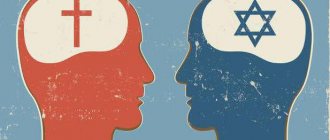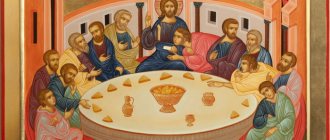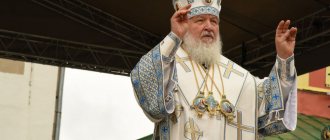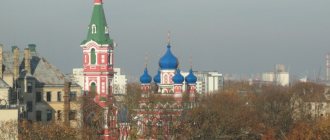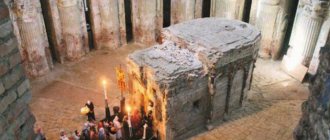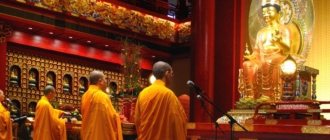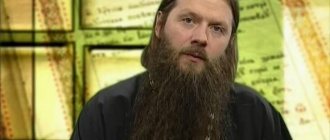Orthodoxy for the Cossacks
Orthodoxy for the Cossacks was the basis of their worldview, philosophy of everyday and army life. However, one must understand that what is meant here is not Orthodoxy in the necessarily canonical sense. What was more important and valuable for the Cossacks was the personal relationship between the human soul and the Creator. Orthodoxy for the Cossacks is not just faith in God or the Church. The Orthodox faith, including the Old Believer, is the foundation of all Cossack life. Every Cossack’s birth, baptism, wedding, burial, in general, the entire life cycle, was associated with the Church. The Orthodox faith of the Cossacks was closely intertwined with everyday life, economy, family traditions and military service (military service). The whole year was interconnected with the church calendar. For example, hay began to be cut after the feast of the Holy Trinity, and grapes were harvested after the Nativity of the Virgin Mary was celebrated.
Descendants of the Khazars
The first written mention of “robbers” on the Don in tsarist government documents dates back to the 16th century, when the lands of the former Golden Horde were subordinated to Moscow one after another. The first famous chieftain, who greatly annoyed the Nogais, was called Sary-Azman.
However, historians trace the origins of the Cossacks to much earlier times. Vasily Pudavov in “The History of the Don Army,” published in 1890, repeats the thesis of the researcher, Fyodor Moroshkin, that the “free Cossacks” were “the most ancient nobility of world history.” Pudavov himself called the Donets the “Slavic-Turanian princess” of Eastern Europe. The name of Sary-Azman speaks volumes about how strong the Turkic element was. Even the name “Cossack” itself, according to Ataman Pyotr Krasnov, comes from the Turkic “gozak” - “lightly armed mounted warrior”. Others, however, translate the word qazaq as “homeless” or “wanderer.”
The Slavic element in these places can be traced back to the times of the Don Slavs, who lived in the upper reaches of the Don from the 7th century. While the Varangian princes conquered the tribes on the Ilmen and Dnieper, the Turkic Khazaria strengthened on the Don. After the defeat of the Khazar Khaganate, Kievan Rus controlled the banks of the Don only sporadically. For example, the city of Belaya Vezha (Sarkel), captured by Svyatoslav Igorevich, was subordinate to the Russian princes until the 12th century, until it was completely depopulated as a result of the Polovtsian raid. Until 1709, the Don people were actually not subject to centralized authority, following the ancient customs and traditions of the steppe freemen. Therefore, it is not surprising that Judaism, adopted as the state religion by the Khazar elite, was preserved to one degree or another among the Cossacks even at a time when most of these people already professed Orthodoxy. Apparently, the Christian faith was finally established on the Don only with the power of the Moscow Tsar in the 16th century.
Orthodox faith in the education of Cossacks
All the most important things, including faith, as well as the behavior and way of thinking of the Cossacks, were initially absorbed in the family. Everything was built exclusively on the generic principles of existence. Until the age of seven or eight, the Cossack boy lived in the female half of the kuren. This did not happen by accident. At this period of his life, he received the education he needed from the female part of his family. In addition, he observed the behavior of both sexes, the relationship between Cossacks and Cossack women. The basic principle was visibility, therefore it was important that the Cossack had before his eyes the personal example of his older relatives.
The Cossack habitat is an important component of the entire Cossack life. There was always a checker on the wall in every kuren. Grandfather's or father's. The Cossacks had whips at the door and in their hands. The Cossack boy observed that people close to him were wearing stripes, hats, and caps. Without fail, everyone had breast crosses on their chests as a symbol of the Orthodox faith. And also medals for military merit; they were a kind of reflection of the honor and valor of the men in the family as warriors and defenders. At the same time, during this period of the formation of a Cossack girl, all the men watched very closely how the personality of the growing Cossack woman was being formed. Women were convinced that it was inappropriate to “little” him.
For example, Cossack girls were not allowed to cry if they hurt themselves or fell; they were instructed to be courageous and persistent from an early age. It was at such moments that children developed the conviction that everything that their elders talk about, what they sing, how they behave is reality. After all, it was important not just to say something, but also to demonstrate by example, and this is what shaped the right actions in the future and present. The games the Cossacks played with their peers were not just entertainment either. They carried certain functions and were primarily aimed at their development. These games were certainly carried out under the sensitive and strict supervision of the elderly. It was important to monitor the behavior of each Cossack girl. And if suddenly someone began to behave unworthily, the elders corrected and taught. In different years of Cossack life, certain events were mandatory. For example, at the age of sixteen, each Cossack faced a rather serious test - he had to hunt a predatory animal. Gradually, the little Cossack, as he grew up, was immersed deeper and deeper into the life, way of life, faith and, in general, the way of life of the Cossacks.
Original
Cossacks and faith
Faith for the Cossack class was a fundamental factor of existence. Any more or less significant business or event in the life of the Cossacks was preceded by a prayer that blessed and protected the brave warriors and supported their faithful companions. From an early age, brought up in the traditions of Christianity, from the moment of baptism to the funeral feast, they sacredly honored the faith of their ancestors, in the struggle for which they laid down their lives without fear.
Regardless of what direction of Christianity the Cossacks professed, both in everyday life and in war they showed amazing religiosity.
Be sure to attend divine services, they strictly observed all the canons and prohibitions inherent in their church, and when celebrating the main holidays - the Nativity of Christ, Easter, Trinity, they followed their own rites.
Every new day and meal, visiting friends and going to work, Cossack gatherings and rest began with prayer, and the church calendar measured out the economic milestones of their peaceful life.
Every Cossack necessarily knew the prayers of his great-grandfathers, which he read earnestly before the battle. To help him defeat the enemy and return home, sabers, swords and protective clothing, illuminated and prayed for before the campaign, were to be used.
DON COSSACKS
The Don Cossacks, who adhered to canonical Orthodoxy, sacredly revered all church traditions, supplementing them with their own specific customs. Such innovations include a religious ceremony timed to mark the departure of the Donetsk to the service, as well as a thanksgiving prayer service ordered by relatives upon his return.
Before leaving for service, each son had to receive the blessing of his father, who, holding an icon in his hands, bequeathed to the young man to always remember God and his commandments, and to honorably pay his military duty to the sovereign and the Fatherland.
Afterwards, all the recruits and villagers gathered at the chapel, where mass was held, during which the Cossacks asked St. Nicholas the Wonderworker for protection and help.
A characteristic feature of the military prayer traditions of the Don Cossacks is the organic interweaving of folklore spells into them. From generation to generation, these church-superstitious formulas served as an additional talisman for warriors in their constant presence at the borderline of life and death.
A wide variety of military prayer conspiracies of the Donets became known to the public thanks to the publications of Leonid Maykov.
Sacred texts passed from father to son were kept in the red corner of the house in peacetime, and on the day of departure to war they were placed in an amulet or inserted into the seam of a shirt. Together with a handful of native land and an icon, they formed a so-called security complex.
During the Great Patriotic War, many Cossacks kept family prayer charms in embroidered pouches, firmly believing in divine protection.
GREBENSKIY COSSACKS
The Grebentsi, who began to settle in the North-Eastern Caucasus in the 16th century, strictly adhered to the foundations of the Christian faith of their fathers. At a time when churches had not yet been built at the new place of life and service, the Cossacks gathered in one of the houses, which was considered a prayer house, to conduct joint ceremonial rituals.
Due to the lack of clergy who had the right to perform church sacraments, the Greben people at first used alternative worship. Thus, the most important for the self-identification of any Cossack, the rite of Baptism took place in the waters of the Terek River; at Communion, each man bit the end of his beard, which was considered sacred, and the rite of Repentance was replaced by self-repentance.
Since their entire existence was permeated with religiosity, they, for centuries in close contact with the Muslim peoples of this region, still managed to maintain the purity of their faith.
The Greben Cossacks did not renounce its foundations even after the church schism that occurred in the second half of the 17th century. Continuing to strictly observe and perform the religious rites of their ancestors, they did not participate in political and church disputes between Nikon’s supporters and schismatics, standing on the fact that without adding or subtracting anything they professed the faith inherited from their grandfathers and fathers.
Defending their own identity, they continued to cross themselves with two fingers, made a procession across the sun (posolon), and prayed according to old church books.
There was no anti-government or anti-patriarchal subtext in the actions of the Greben residents; they simply continued to pray and serve the Lord according to the inherited early Christian canons, trying in every possible way to stay away from the schismatics who flooded the Caucasus.
Distancing themselves from the latter, the Greben Cossacks often repeated that the right to the “old faith and two-fingered baptism” was granted to them by Emperor Peter I for their valiant service to the Fatherland.
By the way, recognizing the leading role of the Greben residents in protecting the southern borders of the Russian Empire, the authorities turned a blind eye to their adherence to the Old Believers, and did not try to persecute or forcefully persuade them to accept official Orthodoxy.
YAIC COSSACKS
Much more sad was the fate of the Ural Cossacks, who, not wanting to change their Old Believer beliefs and actively accepting schismatics from all over Russia into their ranks, turned against themselves the government of the country, which more than once persecuted them.
Refusing to obey the official church, the Yaik Cossacks rebelled whenever they were forbidden to pray in houses of worship, urging them to visit Orthodox churches. By the way, the local atamans were against the construction of churches, since in the ranks of the Yaik Cossacks, in addition to various kinds of Old Believers, such as Popovtsy and Bespopovtsy, Dyryniki and Timofeevtsy, Lamaists and Muslims served.
Recognizing the human right to freely choose faith, the Urals respected the traditions of adherents of other religions, and always repeated the phrase: “They have theirs, we have ours, but the state is common, so the difference of beliefs does not interfere with common service.”
In order to somehow resolve the situation in 1800, the emperor established the Old Believer direction of Edinoverie, upon the transition to which the Cossacks received the right to preserve the Old Russian way of life, conduct worship according to pre-Nikon books and rituals, but submit to the Russian Orthodox Church.
Among the Yaik Cossacks, the common faith was introduced by violent methods, and those who resisted praying in the temple according to the behests of their ancestors were sent into exile.
Saint Sergius of Radonezh (1314-1392)
Sergius of Radonezh (in the world Bartholomew; “Radonezh” is a toponymic nickname; May 3, 1314 - September 25, 1392) - a monk of the Moscow Church (Constantinople Orthodox Church), founder of the Trinity Monastery near Moscow (now the Trinity-Sergius Lavra).
Saint; reverend; revered as the greatest ascetic of the Russian land; transformer of monasticism in Northern Rus'.
Days of remembrance according to the Julian calendar: July 5 (discovery of relics), September 25 (death).
Saint Dmitry of Rostov (1651-1709)
Dnieper Cossack and Metropolitan, canonized. In the world he bore the name Daniil Puptalo, was from Makarov, Kyiv province, studied at the Kiev-Mohyla Academy and, after graduating, soon entered a monastery. He was elevated to the rank of bishop from the abbot of the Spaso-Preobrazhensky Monastery in Novgorod Seversky, and in 1701 with the title of metropolitan he was appointed to the see in Rostov-Yaroslavl. In the monastic rank he devoted himself entirely to spiritual exploits, but, in addition, was engaged in scientific and literary activities. October 28, 1709 buried in the church of the Rostov-Yakovlevsky Monastery. In 1752, it was accidentally discovered that his body was not exposed to decay. Five years after this, he was canonized and glorified as a saint of the Orthodox Church, and his relics were opened for veneration.
Saint Alexander Nevsky (1221-1263)
Alexander Yaroslavich Nevsky (May 30, 1221 Pereslavl-Zalessky - November 14, 1263, Gorodets) - Prince of Novgorod (1236-1240, 1241-1252 and 1257-1263), Prince of Kiev (1249-1263), Grand Duke of Vladimir (1252-1263) .
Canonized by the Russian Orthodox Church in the ranks of the faithful under Metropolitan Macarius at the Moscow Council in 1547. Memory (according to the Julian calendar): November 23 and August 30 (transfer of relics from Shlisselburg to the Trinity Cathedral on August 30, 1724).
Days of celebration of St. Alexander Nevsky:
May 23 (June 5, new art.) – Cathedral of Rostov-Yaroslavl Saints
August 30 (September 12 according to the new art.) - the day of transfer of the relics to St. Petersburg (1724) - the main one
November 14 (November 27 according to the new art.) - day of death in Gorodets (1263) - canceled
November 23 (December 6, New Art.) – day of burial in Vladimir, in the schema of Alexy (1263)
"Judaizing" Cossacks
Some of the Cossacks performed Jewish rituals in the form of the “Sabbath faith.” By being baptized, these people simultaneously observed the laws of the Old Testament. This religious movement among the Cossacks is correlated with the “Subbotnik” sect, widespread in the south of Russia - in the Voronezh, Tula, Saratov, and Oryol regions.
There is evidence that in 1871, Emperor Alexander II met Jewish Cossacks in Tsaritsyn - he noticed that some Cossacks did not take off their hats in front of him. They explained to the king that they were doing this according to the requirements of the Mosaic Law.
Bearers of the Jewish faith were also found among the Cossacks, as well as among the Meshchera Cossacks, who were closer to the Don people. At the end of the Time of Troubles, the latter were expelled by order of Metropolitan Philaret and settled in Lithuania, joining the Karaites.
One of the centers of Judaism on the Quiet Don was the town of Kagalnitsky, founded by Stepan Razin in 1610. Its name is derived from the word “kahal” (self-government body of the Jewish community). As of 1910, there were 36 open Jews in Kagalnik, and there was a Jewish cemetery. As a Cossack from Kostroma, Efim Podoksik, a writer, Mikhail Sholokhov recalled, at a meeting he asked him about the town of Kagalnitsky, and also argued that “as long as there is a confrontation between Orthodoxy and Judaism, there will be no truth.”
“The most important, most beloved and sincerely written hero by him, Grigory Melekhov, is “like a Turk.” By the way, “melech” in Hebrew means “king,” Podoxik noted.

